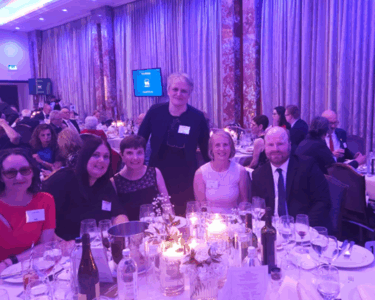‘Behind the scenes’ is a series of thought-provoking but accessible blog-style features that share some of the challenges members of our team experience when developing CPD sessions and classroom materials for teachers. The series incorporates insights and thought processes we have been unable to include, or explore fully, in our lesson plans. Our hope is that sharing the challenges we have faced will be interesting for teachers and lend further nuance and complexity to material being used in the classroom.
Behind the Scenes: April 25
2. Talking Archives: Sabbath Rest, the Ben Uri Gallery, and ‘Who were the six million?’
By Tom Haward
This post may be of particular interest to teachers teaching the Centre’s lesson ‘Who were the six million?’ and those interested in using visual forms of evidence in the classroom.
Working at the UCL Centre for Holocaust Education I am part of a team providing continuing professional development (CPD) in Holocaust education for teachers. We spend much of the time developing classroom material informed by the Centre’s research in addition to running sessions which model pedagogical approaches to support educators in teaching the material we devise.
Who were the six million?
Our Centre has always believed it important to teach about Jewish life before the Second World War when students study the Holocaust for a number of reasons: to provide students with a sense of ‘what was lost’ as a result of the Holocaust; to develop knowledge and understanding of the diversity of Jewish life before the war, and in so doing challenge some common misconceptions revealed by the Centre’s research into what students know and understand about pre-war Jewish life; and to start to indicate and refute some common features of antisemitism, and the myths and misconceptions that underpin them.
To this end we have developed a lesson that has gone through several iterations and has come to be known as ‘Who were the six million?’ In one of those iterations I was conscious that our lessons were, quite understandably, often focused on the use of textual information, in particular in the form of case studies. I wanted to explore other media and forms of information, archives we hadn’t used before, and new pedagogical approaches, to both promote access and engagement for students, as well as conveying a particular sense of pre-war Jewish life. This led to a wonderful collaboration with the Ben Uri Gallery, the use of the painting ‘Sabbath Rest’ by Samuel Hirszenberg, and some inspiration from the Museum of Modern Art (MoMA), New York.
The Ben Uri Gallery and ‘Sabbath Rest’
I was looking for something visual to add an extra dimension to students’ understanding of the diversity of pre-war Jewish life that had previously been missing. Ben Uri is the name of an arts society founded in 1915 by Russian émigré Lazar Berson in the heart of the Jewish East End of London. Today the Ben Uri Gallery and Museum is located in St John’s Wood, London, and features the work of émigré artists, describing itself as “The Art Museum for Everyone.” One of the works in its collection is Samuel Hirszenberg’s “Sabbath Rest,” which he painted in 1890. Born in Łódź, he became known for depicting the condition of impoverished Jews in Poland, where frequent antisemitic pogroms caused many to flee to the West.
It struck me that in terms of content, this painting had the power to do many things to convey the diversity of pre-war Jewish life: not only did it emphasise the religious lives that many Jews held fast to, cast in terms of orthodox Judaic tradition, but it also explored themes of migration and exile in the context within which it was painted, as well as providing an inter-generational sense of Jewish identity. Moreover, it provided a way of addressing antisemitic tropes that connected Jews with money, showing as it does a family in poverty.
Ultimately, though, it was the power of the medium of art itself to convey all of this that particularly struck me: the use of colour, of light and shade, of the symbolism of the candlesticks and the Judenstern lamp, of the arrangement of people, that all seemed to convey something text couldn’t. Further, it seemed to be something that students of all abilities could access in some way.
Pedagogical approaches:
Two main pedagogical approaches were developed as suggestions for how teachers might use this painting in the classroom;
- Revealing the image piece by piece
A powerpoint slide can be created to reveal the picture piece by piece, the first section showing just a couple of candles, then a couple of paintings on the wall, followed by a Judenstern lamp hanging from the ceiling, until the whole image is finally revealed. This approach is used to try to encourage students to slow down in their looking and focus on making observations, inferences, and tentative hypotheses that may then be modified in the light of new evidence.
In scaffolding such an approach, teachers can play a critical role through the use of questioning. Suggested questions might include the following:
Observational Questions;
- What can you see?
- How might you describe it?
Inferential Questions:
- What does this tell you?
- When and where do you think it was painted? How can you tell?
- What can you infer about the wealth / beliefs / culture of the people in this setting?
- What do you think the whole picture might look like at this point? How can you tell?
- How certain can you be of your ideas to this point?
The aim is to encourage students to construct a narrative of the painting that reveals aspects of pre-war Jewish life, with teacher guidance, as well as reflecting on the epistemological foundations of their thinking.
Whilst recognising that ‘there are many ways of looking at pictures, none of which can be called the right way’ (Clark, 1960: 15), a key tenet of using art in this way is the need to encourage students to take time in their looking. Gregory (1990: 330-1), for instance, underpins the need for this when he talks of the separateness of the concepts of perceptual and conceptual meaning, the former being the equivalent of glancing, occurring in just a ‘few seconds,’ whereas conceptual understanding ‘works over a far longer time-scale.’
- Using viewfinders
The viewfinder can be used in conjunction with other strategies. It encourages students to take more time with their looking through physically holding the viewfinder, to look more specifically at the details of the image, and to use this to help them construct meaning from the picture. Students can then use it to frame their viewing, either standing in front of a projected image, or using their own A3 copy of the painting. The idea for using them is adapted from their use in educational programs run by the Museum of Modern Art, New York.
Some things teachers may wish to draw out from the painting that inform us about pre-war Jewish life are mentioned below. Much of the context for this is on the Ben Uri website and can be revealed to students once they have developed their initial ideas and hypothesis about the painting:
- The painting is called ‘Sabbath Rest,’ depicting the Friday evening at the beginning of Sabbath for this Jewish family.
- Items such as the candlestick and star-shaped Judenstern lamp, which burns for 24 hours, are symbolic of this family’s piety.
- The family are not particularly wealthy. This counters predominant stereotypes of Jews being innately rich.
- It shows a community in flux, as the theme of migration is emphasised by the ‘Letter from Argentina’ the grandson is reading, encouraging Jewish migration to South America.
- The window is a common motif used by some Polish painters of the time. Here it highlights the contrast between the industrialised modernity of Łódź, then a major textile manufacturing city, with a more traditional interior.
Implications for educators
Often, art is used as an adjunct to text, to ‘illustrate’ words, not only in history books but in history classrooms too. Using the ‘Sabbath Rest’ painting shows visual sources are worthy of rigorous critical examination in their own right. Indeed, they hold paradoxical properties of being instantly visible and accessible, yet also needing time and effort to decipher (Haward, 2019), what Minear calls ‘their simplicity-in-complexity’ which teachers need to be mindful of (2013: 265).
Strategies for slowing down looking, such as the use of a viewfinder, can be helpful here. Viewfinders are inexpensive to make and can be used repeatedly for other visual images. At MoMA old slide cases were used; at the Centre we have created our own from card, and is something you could do fairly quickly and cheaply.
n working with such images, the teacher can play a critical role in helping shape student thinking. As well as those mentioned above, some general critical questions teachers could use with visual sources like this painting could include;
- Why might this image have been painted? What is the artist trying to say, and why?
- Who might this image be created for? Who is the intended audience?
- What role does the artist’s own background and context within which they were working play in helping us understand the painting?
- How has the artist used techniques such as colour and light and dark? Why might this be?
- Is there anything ‘symbolic’ in the image? If so, what is its purpose?
- What might this image say about the time it was created?
- Does this image matter to us today? If so, why?
References and resources
Ben Uri Gallery and Museum at https://benuri.org/ Samuel Hirszenberg’s painting ‘Sabbath Rest’ (1890) can be found in the Ben Uri Pre-Eminent Collection at https://www.benuricollection.org.uk/search_result.php?item_id=54
Clark, K. (1960) Looking at Pictures. London: John Murray.
Foster et al (2016) “What do students know and understand about the Holocaust?” London: UCL Centre for Holocaust Education
Gregory, R. (1990) “How do we interpret images?” in Barlow, H., Blakemore, C. & Weston-Smith, M. (1990) Images and Understanding. Cambridge: CUP.
Haward, T, (2020) How do students engage with visual sources in the teaching and learning of History? British Education Research Journal. DOI: 10.1002/berj.3582
Minear, R.H. (2013) Dr. Seuss Goes to War: The World War II Editorial Cartoons of Theodore Seuss Geisel. New York: The New Press.
Museum of Modern Art, New York at https://www.moma.org/



